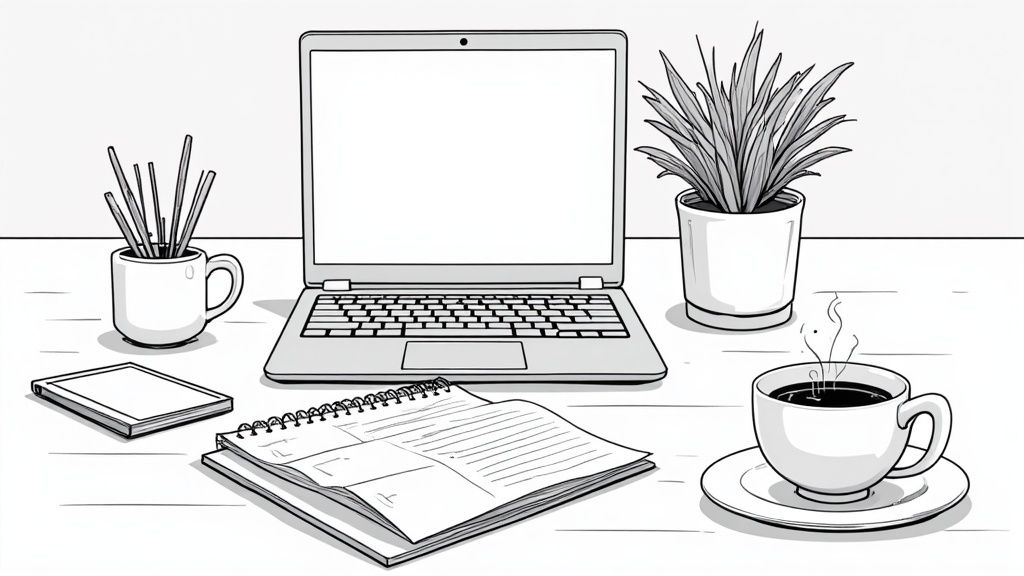How to Improve Work Efficiency: The Science-Backed Guide to Peak Performance
Understanding Today's Workplace Efficiency Challenge
Work and focus have become harder than ever. Constant emails, notifications, and meetings fragment our attention throughout the day. Many people find that working longer hours or sticking to rigid schedules actually makes things worse, leading to exhaustion without better results. As more companies adopt hybrid work arrangements, they're finding new approaches to help their teams work effectively.
The Impact of Employee Engagement on Efficiency
Employee engagement plays a vital role in workplace efficiency. When people feel connected to their work and valued by their company, productivity soars. A recent Gallup study found that only 23% of employees are actively engaged at work. The data shows engaged employees are 18% more productive, 23% more profitable, and 44% less likely to experience stress compared to disengaged workers. Globally, low engagement costs an estimated $8.8 trillion in lost productivity. Learn more about employee engagement and its impact on productivity.
Key ways companies can boost engagement:
Support employee wellbeing
Build strong company culture
Foster positive manager-employee relationships
Identifying High-Leverage Opportunities for Improvement
Rather than chasing every new productivity trend, focus on understanding your personal work patterns. Start by tracking how you spend your time for a week. Look for tasks that take up lots of time but don't deliver meaningful results. This helps identify specific changes that will have the biggest impact.
Some areas to examine:
Time spent in meetings vs. focused work
Common interruptions and distractions
Peak energy times throughout the day
Workspace setup and organization
The Psychological Barriers to Efficiency
Mental blocks like procrastination, perfectionism, and fear of failure can seriously impact our productivity. These show up as:
Putting off important tasks
Getting stuck on minor details
Avoiding challenging projects
Difficulty setting priorities
The key is developing better self-awareness and practical strategies to manage stress and anxiety. With the right mindset and tools, we can create work habits that are both productive and sustainable. Understanding these psychological factors helps build a more balanced, effective approach to work.
Smart Automation for Better Work Results

Moving beyond basic task management tools, real productivity gains come from smart automation. This means finding the right tasks to automate with software tools, giving you more time for meaningful work. Take a moment to consider tasks like sending routine emails, entering data, or coordinating meetings - these are perfect starting points for automation.
Finding the Right Tasks to Automate
Not all work should be automated. Focus on tasks that are:
Repetitive: Work you do over and over
Rule-based: Tasks with clear steps to follow
Time-intensive: Activities that eat up your day
Basic: Work that doesn't need special skills
Keep tasks requiring creativity, problem-solving, or key decisions in human hands. However, many admin tasks, organizing work, and some communication can be automated effectively.
Measuring Automation Benefits
Before starting automation, check if it's worth the effort. Look beyond just time savings to consider:
Fewer mistakes: Automated processes reduce human error
More work done: Free time lets you tackle other projects
Happier teams: Less boring work means better job satisfaction
Research shows that using automation makes a big difference. Top performers are 242% more likely to use AI and 78% more likely to use automation tools than others. Workers who use automation save 3.6 hours each week on average. Learn more about productivity stats here: Employee Productivity Research
Blending Human Skills with Automation
While automation helps with routine work, it works best alongside human skills. Smart teams use automation for repetitive tasks while focusing their people on work that needs thinking, creativity, and emotional understanding. This combination helps teams do their best work. Next, let's look at how your workspace affects your results.
Creating Your Optimal Performance Environment

Your workspace directly affects how well you can focus and get things done. Studies show that a properly designed environment can boost productivity by up to 30%. This includes everything from the physical setup to noise levels and having the right tools within reach. Learn more in this detailed report: Productivity Research: Key Findings on Workspace Design.
Lighting for Focus and Energy
Good lighting helps you stay alert and focused throughout your workday. Try to set up your desk near a window to get natural sunlight. When that's not possible, use good quality lights that match natural daylight. Skip harsh fluorescent bulbs that can cause headaches and eye strain.
Acoustics: Minimizing Distractions
Background noise can really hurt your focus. Some practical solutions include:
Using noise-canceling headphones
Running a white noise machine
Adding soft materials like rugs to absorb sound
Placing furniture strategically to block noise
Ergonomics: Setting Up for Success
The right physical setup prevents pain and helps you work better. Position your chair, desk, and screen at proper heights to avoid strain. If you type a lot, get an ergonomic keyboard and mouse - your wrists will thank you later.
The Psychology of Workspace Design
A messy desk often leads to scattered thinking. Keep your workspace clean and organized. Add a few personal touches like:
Plants
Meaningful artwork
Photos that inspire you
Colors that help you focus
Optimizing Your Remote Workspace
Working from home? Set up a dedicated work area to separate your job from home life. Make sure you have:
Good lighting
A quiet spot away from household noise
A comfortable chair and desk setup
All necessary tools within reach
This investment in your home office space will help you stay focused and get more done each day.
Mastering Strategic Time Management
Let's explore how high performers structure their time for optimal results. The best time management methods flow naturally with your personal work rhythms and energy patterns, helping you achieve more without feeling overwhelmed.
Prioritization for Peak Performance
Effective time management comes down to working on what matters most, not just staying busy. When you focus on high-value activities that directly support your goals, you make real progress. Start by identifying which tasks drive results and which ones you can minimize or eliminate.
Here's a practical framework for sorting tasks:
High Impact, High Urgency: Critical deadlines and problems - address these first
High Impact, Low Urgency: Planning, relationship building, learning - schedule dedicated time
Low Impact, High Urgency: Most interruptions and routine emails - handle quickly or delegate
Low Impact, Low Urgency: Administrative busywork - minimize or eliminate
Timeboxing and Focused Work Sessions
Timeboxing means assigning specific time blocks to particular tasks. Instead of a vague "I'll work on this today," you commit to "I'll complete this from 9:00 AM to 11:00 AM." This creates natural boundaries and helps you maintain focus.
Tips for productive work sessions:
Clear away distractions: Silence notifications, put your phone away, close extra browser tabs
Try the Pomodoro Technique: Work in focused 25-minute blocks with short breaks
Group similar tasks: Minimize mental switching by batching related activities
Building a Realistic and Flexible Schedule
While structure helps, flexibility is key. Life rarely goes exactly as planned. Build a schedule that has room to breathe - include buffer time between tasks to handle unexpected issues. This keeps small delays from throwing off your entire day.
Match tasks to your natural energy patterns. Schedule demanding work when you're typically most alert and save lighter tasks for lower-energy periods.
Protecting Your Time: The Art of Saying "No"
Constant interruptions can derail your productivity. Learning to decline requests that don't align with your priorities is essential. This includes setting boundaries around meetings, unplanned calls, and email responses.
Key strategies to guard your time:
Set clear availability: Let others know when you can and cannot be interrupted
Block off focus time: Reserve specific periods for concentrated work
Use helpful tools: Set up email filters and "do not disturb" settings to minimize disruptions
By applying these practical time management approaches - smart prioritization, timeboxing, and protected focus time - you'll gain more control over your day and see better results from your work hours.
Developing High-Performance Work Habits

Learn how to build work habits that lead to real results. We'll explore science-backed methods for replacing old patterns with new ones that stick, looking at practical ways to work smarter and build systems that last.
The Psychology of Focused Work
Our brains work best when we focus on one thing at a time. Deep work - concentrating fully on a single task - helps us think clearly and produce better results. It's like using a magnifying glass in the sun - scattered rays do little, but focused light creates intense heat. When we give our full attention to complex problems, we find better solutions.
Techniques for Maintaining Peak Mental Performance
Just as athletes train their bodies, we need to keep our minds in shape. The Pomodoro Technique - working in focused 25-minute blocks with short breaks - helps prevent mental fatigue. Simple mindfulness practices like taking deep breaths or a short meditation can clear your head and reduce stress levels.
Building Sustainable Productivity Systems
Long-term success comes from having good systems, not just bursts of effort. This means setting up routines that make focused work natural and easy. Think of it like maintaining a car - regular tune-ups and good habits keep everything running smoothly over time.
Automating Decision-Making for Efficiency
Small choices can drain your mental energy. Smart professionals reduce decision fatigue by automating routine choices - like having set meal options or specific times for checking email. This saves brainpower for harder problems that need your full attention.
Eliminating Willpower Depletion
Think of willpower like a battery - it runs down as you use it. Relying on willpower alone to stay focused or resist distractions leads to mental exhaustion. Instead, build habits that make good work practices automatic. Create an environment and routines where staying focused feels natural, not forced.
Creating an Environment for Efficient Work
Your workspace directly affects how well you work. A messy desk often leads to scattered thinking, while a clean, organized space helps you focus. Good lighting, comfortable temperature, and the right noise level make a big difference in your concentration. Set up your work area to block distractions and support your best work - things like natural light, a good chair, and simple decorations can help you stay focused longer.
Measuring and Maintaining Your Productivity Gains

Getting better at work takes constant attention and refinement. Like checking a map during a road trip, you need to regularly assess if you're moving in the right direction. Let's explore practical ways to track your progress and keep building on your wins.
Identifying Key Performance Indicators (KPIs)
Start by getting clear on what "better" means for your specific role. A writer might track words per hour, while a salesperson focuses on calls made or deals closed. Pick Key Performance Indicators (KPIs) that directly show how well you're doing what matters most. These numbers should connect straight to your main goals.
Here are some practical KPIs to consider:
Daily Output: Number of tasks finished each day
Project Success: How many projects you complete on time and in budget
Core Work Time: Hours spent on your most important tasks
Quality Check: How often mistakes happen and time spent fixing them
Tracking Your Progress Simply
Don't get stuck counting everything. Pick just a few key numbers that really matter and keep tabs on those. Basic tools like a spreadsheet or simple productivity app work great for this.
Try these straightforward tracking methods:
Quick Daily Notes: Write down what you finish and how long it took
End-of-Week Check: Look back at what worked and what didn't
Building Feedback Loops for Real Growth
Take time each week to look at your numbers and spot patterns. When you notice something's not working - like too many interruptions during focus time - you can fix it right away. This simple cycle of checking, learning, and adjusting helps you steadily get better at your work.
Keeping Your Gains: No Backsliding
Once you've made progress, protect it. Keep using the methods that work for you and regularly check your numbers. Think of it like tending a garden - you need to stay on top of things to keep everything healthy. This steady attention helps you not just reach your peak but stay there.
Want to manage your tasks and track habits all in one place? Obsibrain brings together everything you need to stay productive and reach your goals.
Last updated
Was this helpful?